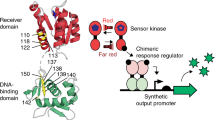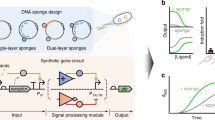Abstract
Characterizing the dynamics of HydHG—a two-component transcriptional regulatory network for exogenous zinc in E. coli—is essential in understanding the biology of these regulatory and signaling pathways. Here, we used a synthetic biology strategy to modify the dynamic characteristics of the HydHG network in two ways. First, a self-activation loop for HydHG network was created under the control of zraP promoter, after which the threshold Zn2+ concentration for the self-activated HydHG network significantly decreased from 200 to 10 μM. Second, the self-activation loop was integrated into the E. coli genome allowing the threshold Zn2+ concentration to be elevated to 500 μM. As the threshold Zn2+ concentration could be modified in both directions, the introduction of a self-activation loop and the entire genomic integration strategy may prove useful for the creation of a two-component bacterial biosensor with varying sensitivities.




Similar content being viewed by others
References
Stock AM, Robinson VL, Goudreau PN (2000) Two-component signal transduction. Annu Rev Biochem 69:183–215
Laub MT, Goulian M (2007) Specificity in two-component signal transduction pathways. Annu Rev Genet 41:121–145
Rensing C, Maier RM (2003) Issues underlying use of biosensors to measure metal bioavailability. Ecotox Environ Safe 56:140–147
Kahru A, Ivask A, Kasemets K, Põllumaa L, Kurvet I, François M, Dubourguier H (2005) Biotests and biosensors in ecotoxicological risk assessment of field soils polluted with zinc, lead, and cadmium. Environ Toxicol Chem 24:2973–2982
Liao VHC, Chien MT, Tseng YY, Ou KL (2006) Assessment of heavy metal bioavailability in contaminated sediments and soils using green fluorescent protein-based bacterial biosensors. Environ Pollut 142:17–23
Peca L, Kós PB, Máté Z, Farsang A, Vass I (2008) Construction of bioluminescent cyanobacterial reporter strains for detection of nickel, cobalt and zinc. FEMS Microbiol Lett 289:258–264
Liu P, Huang Q, Chen W (2012) Construction and application of a zinc-specific biosensor for assessing the immobilization and bioavailability of zinc in different soils. Environ Pollut 164:66–72
Brocklehurst KR, Hobman JL, Lawley B, Blank L, Marshall SJ, Brown NL, Morby AP (1999) ZntR is a Zn(II)-responsive MerR-like transcriptional regulator of zntA in Escherichia coli. Mol Microbiol 31:893–902
Binet MRB, Poole RK (2000) Cd(II), Pb(II) and Zn(II) ions regulate expression of the metal-transporting P-type ATPase ZntA in Escherichia coli. FEBS Lett 473:67–70
Leonhartsberger S, Huber A, Lottspeich F, Böck A (2001) The hydH/G genes from Escherichia coli code for a zinc and lead responsive two-component regulatory system. J Mol Biol 307:93–105
Savageau MA (1975) Significance of autogenously regulated and constitutive synthesis of regulatory proteins in repressible biosynthetic systems. Nature 258:208–214
Chang D-E, Leung S, Atkinson MR, Reifler A, Forger D, Ninfa AJ (2009) Building biological memory by linking positive feedback loops. Proc Natl Acad Sci USA 107:175–180
Thattai M, van Oudenaarden A (2001) Intrinsic noise in gene regulatory networks. Proc Natl Acad Sci USA 98:8614–8619
Salis H, Tamsir A, Voigt C (2009) In: Collin M, Schuch R (eds) Bacterial sensing and signaling. Karger, Basel
Miller WG, Leveau JHJ, Lindow SE (2000) Improved gfp and inaZ broad-host-range promoter-probe vectors. Mol Plant Microbe In 13:1243–1250
Sambrook J, Russel DW (2001) Molecular Cloning: a Laboratory Manual, 3rd edn. Cold Spring Harbor, New York
Datsenko KA, Wanner BL (2000) One-step inactivation of chromosomal genes in Escherichia coli K-12 using PCR products. Proc Natl Acad Sci USA 97:6640–6645
Acknowledgments
This research was supported by the Basic Science Research Program through the National Research Foundation of Korea (NRF) funded by the Ministry of Education, Science and Technology (2010-0012850).
Author information
Authors and Affiliations
Corresponding author
Additional information
V. D. Pham and S. Ravikumar contributed equally to this work.
Rights and permissions
About this article
Cite this article
Pham, V.D., Ravikumar, S., Lee, S.H. et al. Modification of response behavior of zinc sensing HydHG two-component system using a self-activation loop and genomic integration. Bioprocess Biosyst Eng 36, 1185–1190 (2013). https://doi.org/10.1007/s00449-012-0845-7
Received:
Accepted:
Published:
Issue Date:
DOI: https://doi.org/10.1007/s00449-012-0845-7




